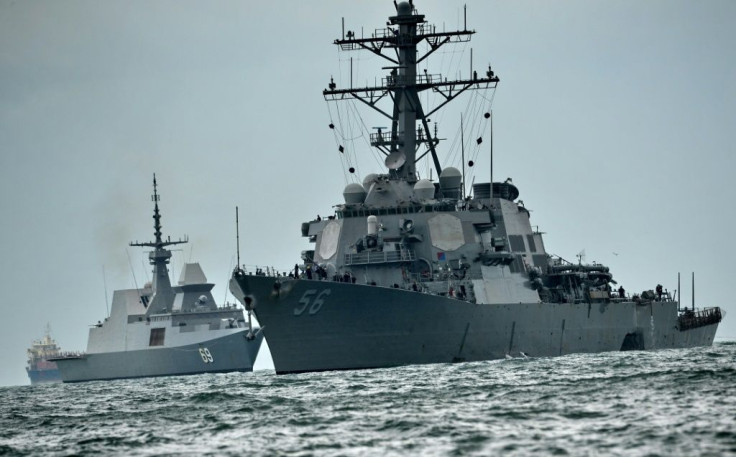Taiwan Strait: China Mocks US Navy's 'Old Warships' But Washington Has Called Beijing's Bluff
KEY POINTS
- This was also the first reported transit by two U.S. Navy cruisers in the past four years
- Chinese experts said the sailing of U.S. vessels through the Taiwan Strait was pointless
- China did give any additional statements though the transit happened days after PLA drills
The People's Liberation Army (PLA) reacted to the U.S. warships' transit through the Taiwan Strait on Sunday, stating it had monitored the entire passage of the vessels and everything was under control. Though Beijing's reaction wasn't unexpected, this time though, it lacked the usual fierceness. The response had been a muted one.
Hours after the U.S. Navy 7th Fleet sent Ticonderoga-class cruisers USS Antietam and USS Chancellorsville through the Taiwan Strait, the PLA Eastern Theater Command Spokesperson Shi Yi issued a statement. "The Theater Command's troops keep high alert and are fully prepared to crackdown any provocation anytime," according to Global Times.
There was no additional response, though the transit came just days after China held massive live-fire drills near the strait. This was also the first reported transit by two American cruisers in the past four years. Every other time, the U.S. had sent destroyers, much-smaller vessels.
In June, China claimed that there was no such thing as "international waters" while rejecting the idea of the Taiwan Strait as international waters. A month later, the U.S. sent its warship USS Benfold through the strait. Chinese response had been sharp, calling the U.S. a "maker of security risks." It also called out Washington for its "provocations."
This time, even the Chinese mouthpiece Global Times took a mellow approach. A report, quoting experts, said "as long as the U.S. vessels follow the rules of 'innocent passage' to keep a low profile and pose no harm, turn off weapons and fire-control radar system, and bring no actual threat to China's security, the PLA would just follow and monitor."
It said, "there is no big difference this time as the U.S. also doesn't want to put its old warships in danger." However, the report did dismiss the transit as a U.S.' attempt to "interfere in the reunification process with force."
"During wartime, the U.S. warships, whether cruisers, destroyers or even aircraft carriers, can't survive in the Taiwan Straits if they interfere in the reunification process with force, because they are too close to the mainland and can't survive the saturation attacks launched by the PLA's land-based missiles. So if the U.S. Navy wants to deter the PLA, sailing through the Taiwan Straits is actually pointless and meaningless," Song Zhongping, a Chinese military expert and TV commentator, told Global Times.
The mouthpiece also took a dig at the warships, saying the U.S. sent cruisers because it is "fully aware of and fear of the PLA's capability so that it needs two warships to accompany with each other to embolden themselves."
"To be honest, sending warships to sail through the Taiwan Straits following the rules of innocent passage is not even a provocation from a military perspective, it's just a pointless showcase with a provocative attitude. The U.S. is now very carefully calculating the risks and gains of making such a showcase," Lü Xiang, an expert on U.S. studies at the Chinese Academy of Social Sciences, told the Global Times on Sunday.
However, China continued with its military posturing around Taiwan as 23 Chinese aircraft and eight Chinese ships were tracked around Taiwan on Sunday.
Meanwhile, regional analysts believe the U.S. was showing it would continue to act as it had before Pelosi's trip by sending the vessels. "If the US does not continue to enter the strait, it would show that Beijing's warnings had worked. Of course, the U.S. cannot create this misunderstanding and must send ships to the strait," Lu told South China Morning Post.
Even after China's saber rattle following Pelosi's visit, the U.S. had reiterated that it would continue to operate in the region. "We'll continue to fly, sail, and operate where international law allows, consistent with our longstanding commitment to freedom of navigation, and that includes conducting standard air and maritime transits through the Taiwan Strait in the next few weeks," Kurt Campbell, U.S. President Joe Biden's coordinator for the Indo-Pacific, had then told reporters.

© Copyright IBTimes 2024. All rights reserved.





















